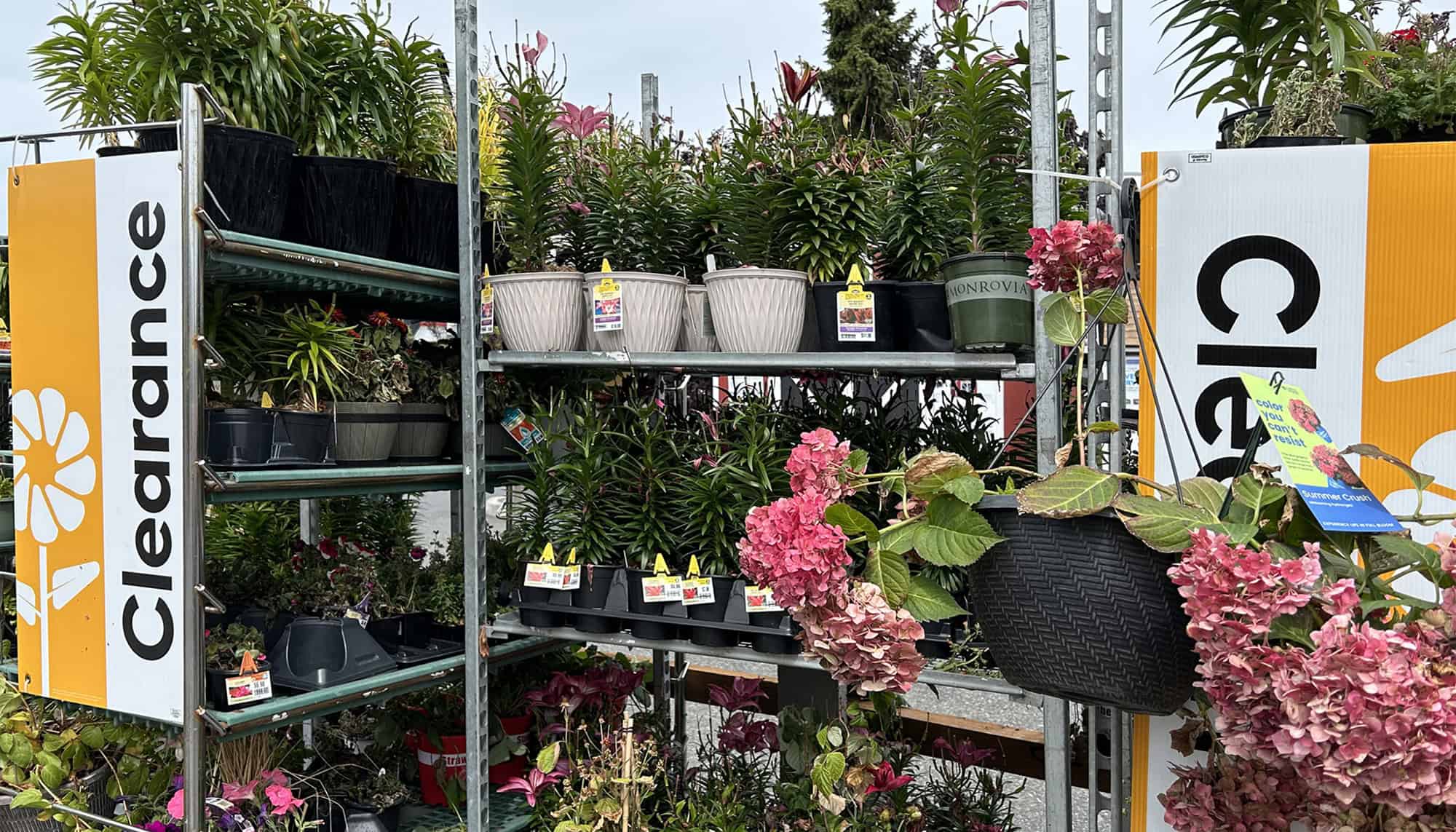Sale Plants


What to do with your late-season bargain plant purchases?
Now that you’ve found those irresistible gems at marked-down prices how do you set them up for success in their new home?
By: Diana Wisen, Skagit County WSU Extension Master Gardener
It's late summer, and you've found some plants on sale that are calling to you. Gardeners, like everyone else, love a good bargain. But when is a marked-down plant a good buy, or is something better left on the rack? Gardeners tend to be "nurturers" who hope that with plenty of TLC, they can nurture a plant back to full health. That may or may not be possible. You rarely can heal sick plants. Despite your efforts, diseased or heavily damaged plants are not a bargain at any price. Be forewarned! You could be bringing additional problems into your yard.
Nevertheless, you have given into temptation and brought home several marked-down plants. Now, what to do with them? First, take them out of your vehicle as soon as you get home, put them in a shady, cool place, and water them well. Allow the plants to drain. Once they are fully hydrated, do not leave them in standing water. Roots need air and will suffocate if left in standing water for several days. Check for baby slugs by sliding the plant out of its container. Also, check for healthy roots before putting it back in its container. Cut off dead stems, leaves, and flowers, but leave all healthy leaves so the plant can photosynthesize and grow.
Do you have a place in mind for each plant? Buying plants without a place to plant them can lead to a "Driveway Garden" with many potted plants sitting too long on the path to your house while waiting to be planted in your garden. This is not an unheard-of dilemma among gardening friends. However, let's assume you have a place for your plant. Check for pests, disease, and damaged parts, including the roots, before planting. This should be done before you purchase the plant, but it's better now than after it's in the ground. Look for aphids, root maggots, beetle larvae, brown mushy (dead) roots, wounds on the stems, and diseased leaves. Sometimes, you can get away with cutting off diseased portions, but often the disease is in the vascular system and plants don't "heal" like humans do. If you suspect disease, it is best to put the entire plant in the garbage can, not in your compost pile.
Check for healthy roots. Cut off dead stems, leaves, and flowers, but leave all healthy leaves so the plant can photosynthesize and grow.
Where to put your new plant
Read the plant tag to learn the conditions the plant needs to thrive. Can you provide the right kind of soil and drainage? What about the amount of sun or shade? Heat requirements? Wind protection? Are deer a problem? It is your job to give your plant what it needs. It cannot get up and move to a better site by itself.
How to plant
Planting is best done on a cool day or in the evening of a hot day. Water the plant and the planting spot ahead of time. Dig a hole the same depth as the plant's root mass and three times as wide. Loosen the soil around the sides of the planting hole so the roots can grow outward. Place the plant in the hole and fill with the soil you took out. Water it in to settle the soil. Light mulching can help retain soil moisture and reduce weeding.


For shrubs and trees, the root flare supporting the trunk should be clearly visible and not covered with soil or mulch. Take the plant out of the container and examine the root zone. Sometimes marked-down plants are root bound and some serious root pruning will be needed before planting. Cut off circling, broken, kinked, or damaged roots. Very long roots may need to be shortened. Do not cut off any of the canopy. Dig a wide, shallow hole, spread the roots straight out in all directions, replace the native soil, and water it in well. Do not stomp on the root zone. Make sure the base of the trunk is at the same level or a bit higher than the soil level. Mulch with arborist chips, keeping them an inch or two from the trunk.
Fertilizing and Care
Sometimes, you can tell by looking at the leaves if a plant is deficient in a nutrient. You need to know what is typical for this plant at this time of year. There are plenty of plants for which yellow or light green leaves are normal. Usually, fertilizing with a diluted nitrogen fertilizer at planting time is helpful. Just go easy on the fertilizer and avoid burning the roots. Too much fertilizer for shrubs, trees, and some perennials can cause excessive weak growth late in the season, which will be subject to winter damage. Soils here in the Pacific Northwest already have plenty of phosphorus. Adding phosphorous can kill the beneficial mycorrhizae. Do not add products such as vitamin B to the soil or spray leaves with a desiccant to prevent wilting. Despite manufacturers' claims, they are not helpful.
A plant is considered established when its root system can take up sufficient water and nutrients for the plant to grow normally. Some shrubs and trees can take over a year, so remember to water them regularly, even if they are drought-tolerant. An arborist chip or homemade compost mulch will help keep the soil evenly moist and add slowly released nutrients. Most purchased composts are fine for a top dressing to retard water evaporation, but they have little or no nutrients left in them because they have been heated to very high temperatures to kill any possible pathogens. Many gardeners now use the "chop & drop" method of leaving plant debris on the soil to decompose naturally and add nutrients to the soil, becoming nature’s slow-release fertilizer.

Container plantings require a different regimen.
Use a light soil mix, not garden soil for container planting. Add some of the compost mixed in well. A sufficiently sized drainage hole needs to be in the bottom of the pot. If slugs crawling in are a concern, put a coffee filter over the hole before filling. Do not put pieces of crockery or a layer of gravel over the hole in the container. New research shows this practice, which is frequently recommended in garden books, actually impedes drainage. Put the potting mix soil to the bottom of the pot so the roots will have plenty of room to grow. While urn-shaped containers are beautiful, they are more challenging to change out later on because the rim curves in and large established roots get caught under it and can be very difficult to dig out. Container plantings dry out much faster than in-ground plantings, especially as the roots grow and fill the pot. Frequent watering causes nutrients to be flushed out sooner so container plantings of annuals will need additional fertilizer during the growing season. A slow-release fertilizer can also be used. Always read the directions thoroughly before using any garden product.
Deadhead annuals to keep them blooming until frost. If they start making seeds that process signals the plants to stop producing additional flowers because they are nearing the end of their life cycle. Some containers can be brought indoors in the winter and continue to thrive if there is sufficient light.
Now it is time to enjoy your new plants. Observe them daily and check to see if they need watering. Watch for plants starting to wilt and water them immediately. It's OK to water plants in the middle of a hot day. Watering them will not cause leaf scorch but will keep your plants alive.
Some perennials may start to die back because they are at the end of their growing season and beginning to go dormant. Plant them properly, and they will come up next spring. Other perennials can be cut back, and they will produce a flush of new growth and perhaps lightly bloom again. Don't forget to bait for slugs and snails, which can be treated the same. This time of year slugs are starting to lay their eggs, which look like masses of tiny white pearls in the moist soil. Slugs and snails live deep in the soil during winter. Read more about managing slugs and snails: https://skagitmg.org/managing_slugs_snails/
With the long growing season in the Skagit Valley, your new bargain plants can give you many months of pleasure. Enjoy the colors, textures, leaf shapes, plant forms, flowers and seeds, fragrances, and the overall beauty they add to your life and your neighborhood. It's your garden. Plant what you love.
REFERENCES AND RESOURCES:
WSU Extension Master Gardener Training Course
Chalker-Scott, L. (2008) The Informed Gardener. Seattle, WA: University of Washington Press.
Chalker-Scott, L. (2009) Sustainable Landscapes and Gardens: Good Science-Practical Application. Yakima, WA: GFG Publishing, Inc.
Gilman, J. (2008) The Truth About Garden Remedies-What Works, What Doesn't, and Why. Portland, OR: Timber Press.
Lowenfels, J. (2013) Teaming with Nutrients: The Organic Gardener’s Guide to Optimizing Plant Nutrition. Portland, OR: Timber Press.

Diana Wisen
ABOUT THE AUTHOR:
Diana Wisen has been a Skagit County WSU Extension Master Gardener since 1991 and is the coordinator of the Fuchsia Garden at the Discovery Garden on SR 536 in Mount Vernon.
Questions about home gardening or becoming a master gardener may be directed to Skagit County WSU Extension Office, 11768 Westar Lane, Suite A, Burlington, WA 98233; by phone: 360-428-4270; or via the website: www.skagit.wsu.edu/mg

Mark your calendar for these upcoming master gardener events:
Skagit County Fair
Thursday ~ Sunday, August 8-11, 2024
Skagit County Fairgrounds
Building D
(map)
Visit our booth, see our displays, and talk with master gardeners about how to make your garden beautiful and productive.
Know & Grow Lecture Series
Season Extenders
Presented by Hallie Kintner
Tuesday, August 20, 2024 ~ 1 p.m.
Free Admission
NWREC Sakuma Auditorium
16650 State Route 536, Mount Vernon
A Second Act for Your Square 1-Gallon Pots at the Discovery Garden!
Bring your leftover square 1-gallon pots to the Discovery Garden (16650 State Route 536, Mount Vernon). The bin for recycling the square 1-gal pots is located in the parking lot, just north (to the right) of the main entrance.
We only need square 1-gallon pots like the ones pictured below (bottom right). The recycling bin will be available now through fall. Simply put your pots into the bin, and we take care of the rest!

Great reminders Diana! Thanks.
Beetles, especially our ground beetles don’t just eat small slugs and snails, but their eggs.